Our gregarious guide Mohammad pointed to the intricate carvings on the wall, “It’s a urinal. I need two volunteers.” Naturally, we were picked to do something this humiliating. Facing towards the ‘urinals’ we were suddenly spun around by his hands. My hand touched Audrey’s fingers and at that particular moment I finally clued in to what was going on.
This particular area was where marriage ceremonies took place and instead of our entire group laughing at us pretending to use the toilet, we shared the same genuine chuckles over the two of us involved in a mock wedding. Oh, how our families will be disappointed/shocked at having not being invited on our special day 😉
Many archaeological sites and/or UNESCO Heritage sites don’t live up to the hype. When I visited the Taj Mahal in Agra I felt a little underwhelmed. Although it was impressive I expected more. I suppose at times I suffer a little bit from my preconceived expectations: Paris Syndrome except in more exotic locales.
However, I must genuinely admit that Petra not only lived up to my expectations – it exceeded them. The sheer size in combination with the impressive architecture helped me channel my inner Indiana Jones 😉
20 Distinct Photos from Petra, Jordan
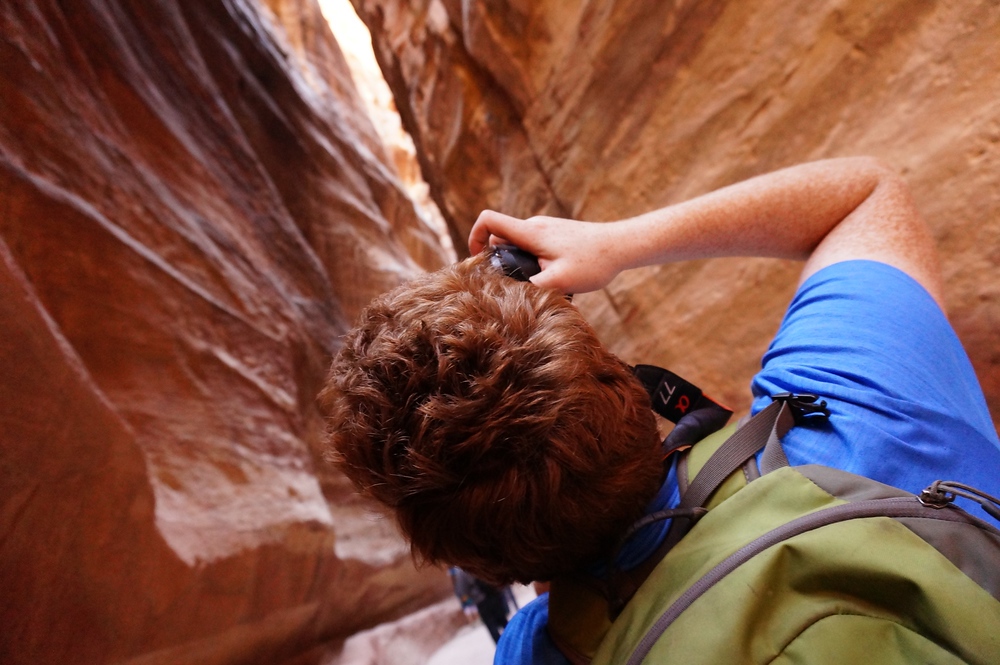
Photo Essay of Petra, Jordan: 20 Unique Photos
As a travel photographer, visiting Petra, Jordan is like a boy realizing a childhood dream of visiting a fantasy land. It was hard to put my camera down; however, I did manage to spend plenty of time taking in Petra with my own two eyes and not just behind the lens.
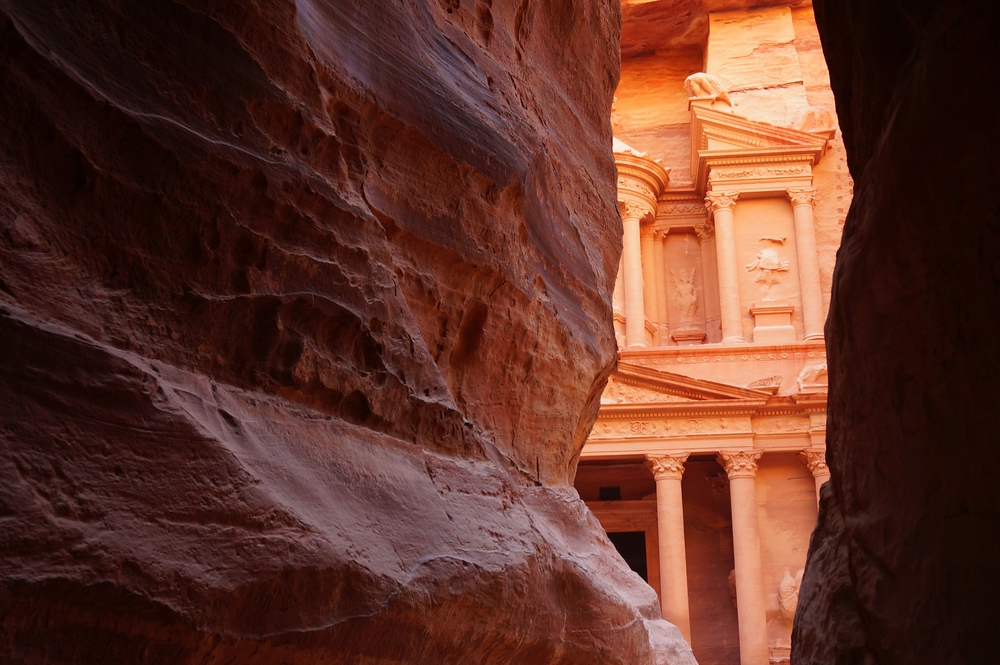
The moment I realized the treasury was mere meters in front of me is one of the most distinct memories I have from Petra, Jordan. Another top moment was hiking the monastery in Petra.
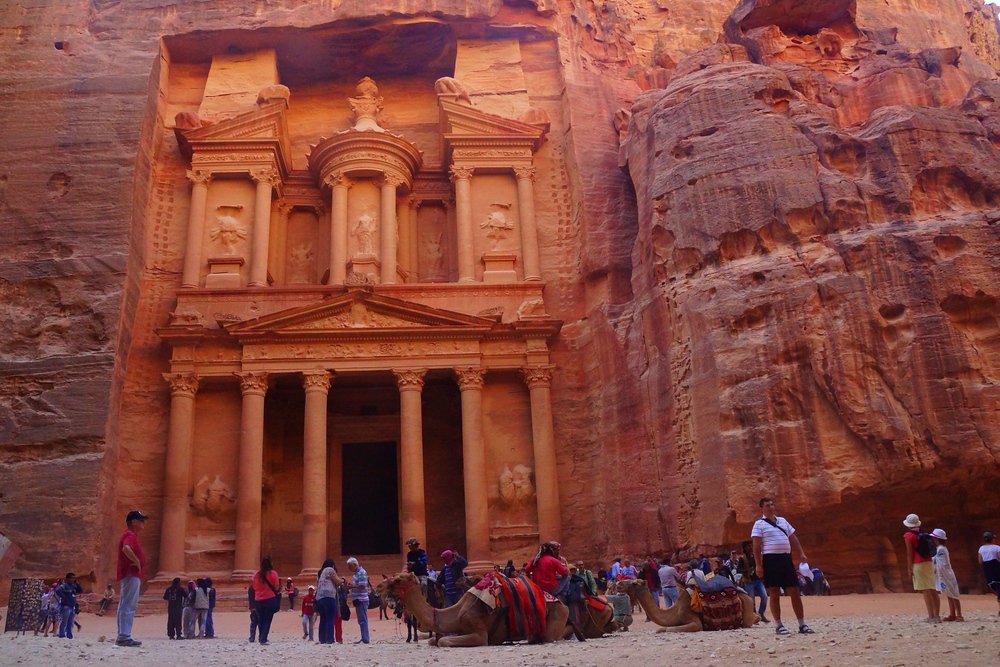
This is the iconic image from Petra, Jordan – a wide angle perspective shot of the treasury. You won’t have this place to yourself though as hoards of tourists, camels and even cats all compete for space.
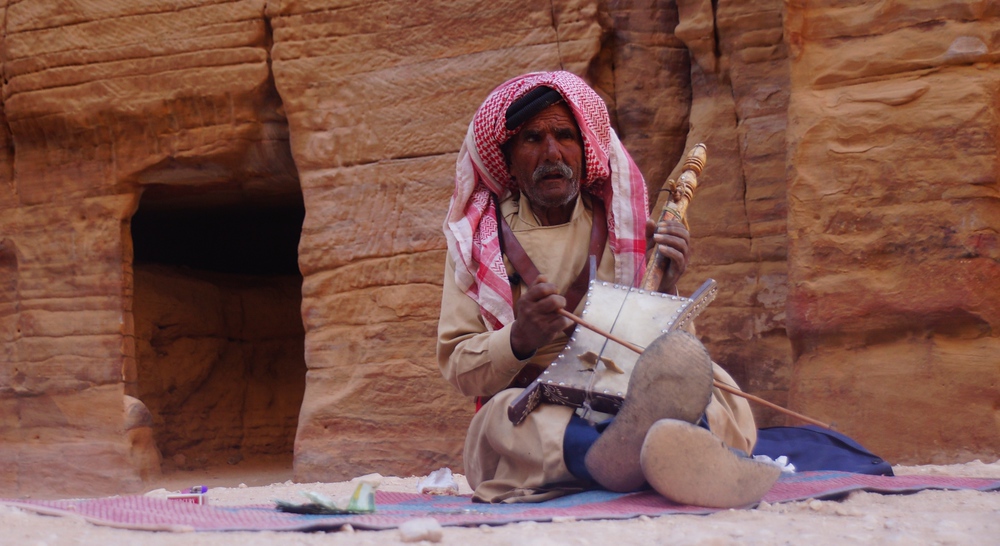
I’ve seen this man many times in photo galleries from other friends who have been to Petra. It was almost surreal getting to take his photo.
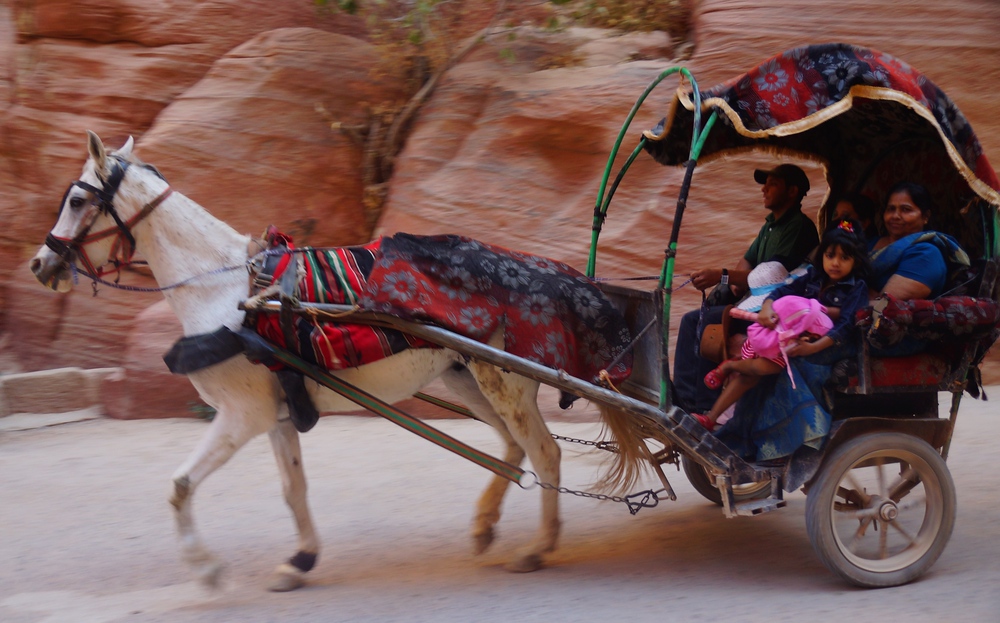
The echoing sound of galloping horses is one in which you’ll learn to familiarize yourself with when visiting Petra

A final shot I took (and edited in sepia) just before sunset.
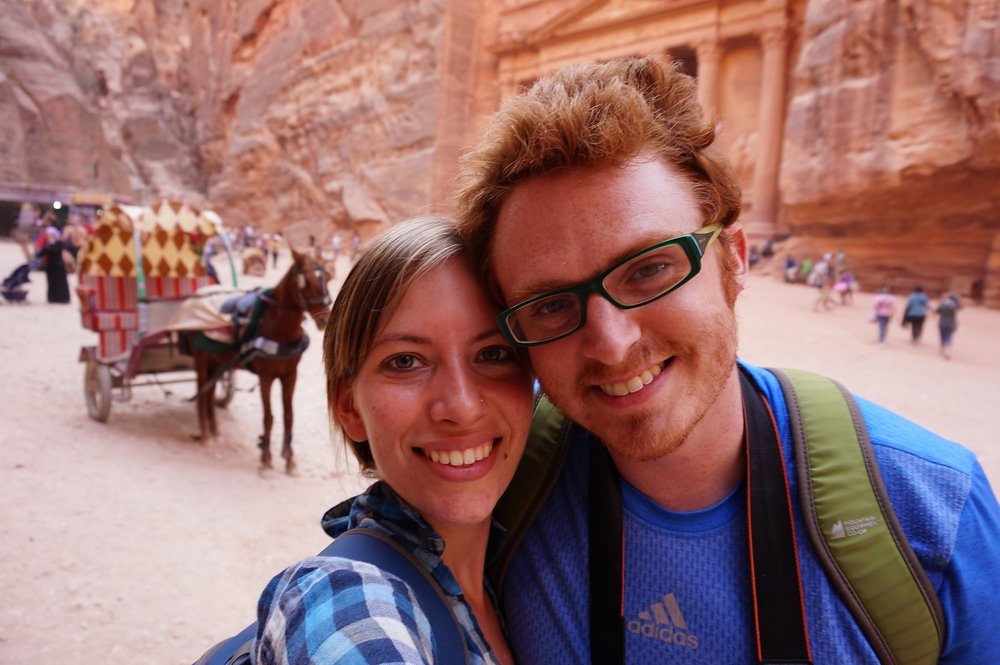
Well, how could we resist not taking a lovey dovey couple shot in Petra, Jordan for our future grandchildren 😉

This man isn’t nearly as imposing as he seems. In fact, I just had to pay him a small fee in order for him to let me pass. He even let me take his photo 😉

I often had to remind myself to turn around and look back. Petra is so grand and massive that you forget sometimes to check your surroundings from the rear.
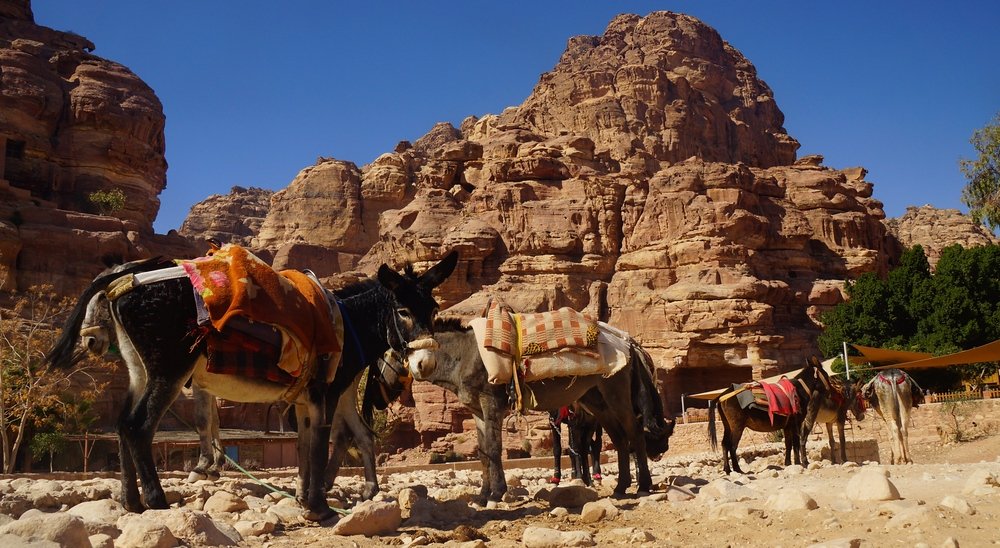
There were no shortage of animal powered transportation options; however, mule certainly seemed less attractive of an option than going by camel or horseback.

No photo essay of mine would be complete with an obligatory shot of a roaming cat. This one was slinking around some trinkets being sold outside of a small shop.

The architecture and especially the intricate carvings boggled my mind. At this point in the day we were exhausted from all of the walking we had done. Worse yet was that the heat was really getting to us; however, we didn’t want to miss out on climbing the steps to get a closer look.

HDR photography came in handy every once in a while given the contrast between the harsh shadows and bright highlights.

Fancy a camel ride? A few days later we rode camels from our Bedouin camp grounds to the area where we’d eventually have breakfast. Camels = 1, Sam and Audrey = 0 To say these lumbering beasts tenderized us would be quite the understatement.
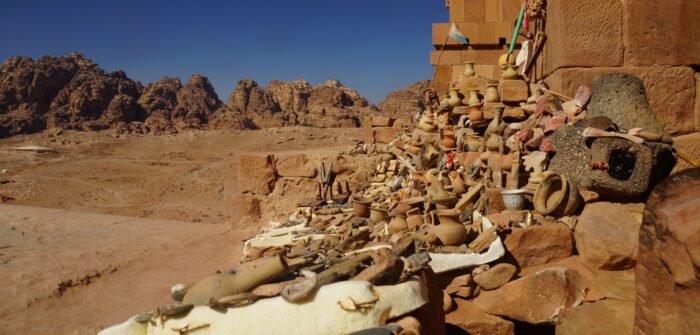
The rewards of climbing steps were that we had a great vantage point view over Petra. On the right you’ll notice many trinkets for sale.
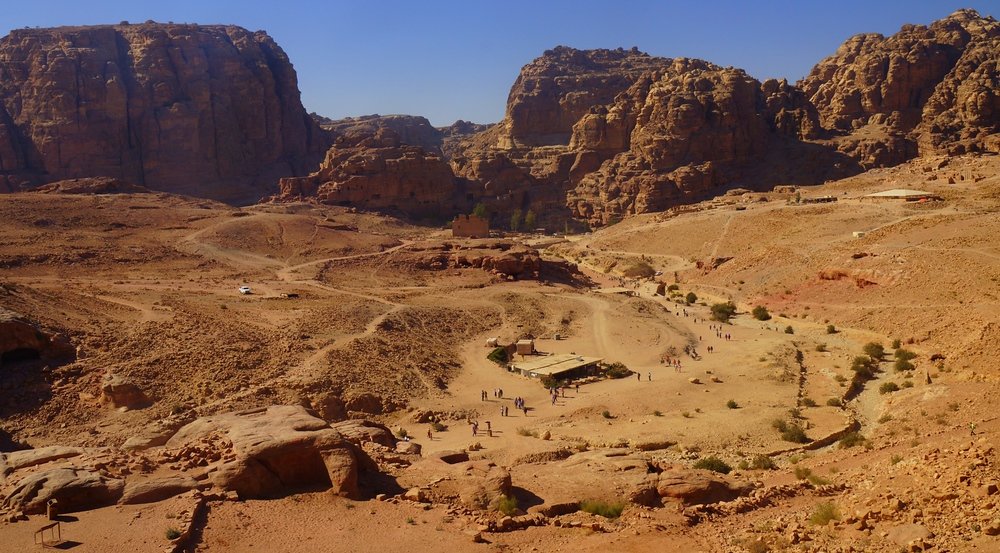
Aside from Angkor Wat and Machu Picchu, I’ve never visited an archaeological site that lived up to its hype and impressed me as much as Petra, Jordan. I only wish I had more time to explore its vast expanse.

As a travel photography tip, don’t forget to look up at your surroundings.

This Bedouin man was waiting on his camel for a tourist to come along an accept his offer for a ride.
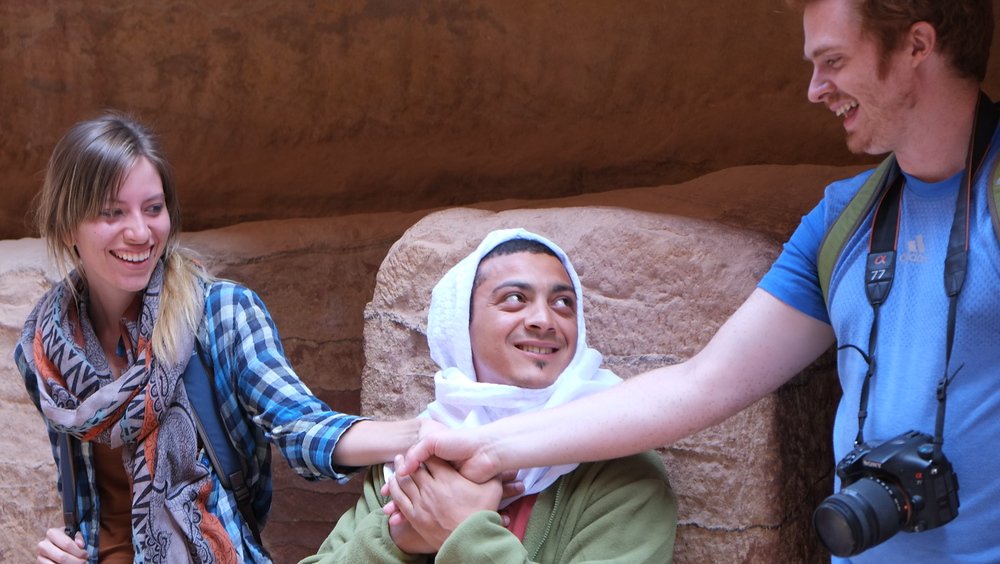
Our surprise wedding at Jordan, Petra was something we’ll never forget. Our families I’m sure won’t either as in the sense they weren’t invited 😉

In order to get a sense of the sheer size of these grounds, I’ve used people in the background as a scale. With more time I would have liked to have had the opportunity to explore more of the frontier areas of the city; however, with just half a day I think I made the most of my time here.
Petra Travel Photography Tips
Petra, Jordan’s most iconic archaeological site, is a dream destination for photographers. With its ancient tombs, towering sandstone cliffs, and the famous Treasury carved into the rock, Petra offers a wealth of photo opportunities that are as diverse as they are breathtaking. Whether you’re a seasoned photographer or a casual traveler with a smartphone, capturing the essence of Petra requires a mix of planning, creativity, and a bit of luck with the light. Here are some essential travel photography tips to help you make the most of your visit to this ancient wonder.
Timing is Everything: Best Times to Shoot
One of the keys to great photography in Petra is getting the timing right. The interplay of light and shadow on the rose-red rocks is what gives Petra its magical quality, and different times of day offer different photographic opportunities.
- Golden Hour Magic: The early morning and late afternoon are the best times to capture Petra’s warm, golden hues. The soft light during these “golden hours” accentuates the textures and colors of the sandstone, making your photos pop with warmth and depth. Arrive early to catch the first light hitting the Treasury, or stay until late afternoon to photograph the Monastery bathed in the golden glow.
- Midday Challenges: While midday light can be harsh, it can also create striking contrasts, especially in the narrow Siq canyon. If you’re shooting during this time, look for opportunities to capture the dramatic play of light and shadow as the sun filters through the high canyon walls.
- Petra by Night: For a truly unique experience, consider attending Petra by Night, where the Treasury is illuminated by thousands of candles. This event offers a magical atmosphere and a chance to capture long-exposure shots of the illuminated façade. Bring a tripod to steady your camera and experiment with different exposure times to capture the glow of the candles against the darkened rock.
Composition Tips: Framing the Perfect Shot
Petra’s grand scale and intricate details offer endless possibilities for creative compositions. Whether you’re focusing on a single structure or trying to capture the vastness of the site, consider these composition tips:
- Leading Lines: The Siq, the narrow canyon that leads to the Treasury, is a natural leading line that guides the viewer’s eye into the frame. Use the curving walls of the Siq to create a sense of depth and anticipation as the Treasury slowly comes into view.
- Foreground Interest: Adding a foreground element, such as a camel or a Bedouin in traditional attire, can add context and a sense of scale to your photos. This approach works particularly well when photographing the larger monuments like the Treasury or the Monastery.
- Look for Reflections: After a rain, you might find puddles in the Siq or other areas of Petra. These puddles can create beautiful reflections of the cliffs and monuments, adding a creative twist to your shots.
- Capture the Details: While the grand monuments are awe-inspiring, don’t forget to zoom in on the details. Look for carvings, inscriptions, and patterns in the rock that tell the story of Petra’s history. These close-up shots can add variety to your photo collection.
Gear and Settings: What to Bring
To make the most of your photography at Petra, it’s important to bring the right gear and know how to use it effectively. Here’s what you should consider:
- Camera and Lenses: A DSLR or mirrorless camera with a range of lenses will give you the most flexibility. A wide-angle lens is ideal for capturing the grandeur of the monuments and landscapes, while a telephoto lens can help you zoom in on details or distant subjects. A standard zoom lens (24-70mm) is also a good all-round option.
- Tripod: If you’re planning on shooting during low-light conditions, such as Petra by Night, a tripod is essential for steady, long-exposure shots. It’s also useful for capturing sharp images in the dimly lit interiors of the tombs.
- Settings: Keep your ISO as low as possible to reduce noise, especially when shooting in bright conditions. Use aperture priority mode to control your depth of field, and experiment with different apertures to see how they affect your compositions. For long exposures, switch to manual mode and set your shutter speed accordingly.
Practical Tips: Making the Most of Your Visit
Photographing Petra isn’t just about the technical aspects—it’s also about how you experience the site. Here are some practical tips to ensure you capture the best possible shots while enjoying your visit:
- Pace Yourself: Petra is a vast site with a lot of ground to cover. Take your time to explore different angles and perspectives. Don’t rush from one spot to another; instead, take a moment to soak in the atmosphere and let the inspiration come to you.
- Respect the Site: Remember that Petra is a UNESCO World Heritage site with great historical and cultural significance. Always be respectful of the monuments and the local customs. Avoid climbing on the structures or disturbing the environment.
- Stay Hydrated: Petra can get very hot, especially in the summer months. Carry plenty of water, wear sunscreen, and take breaks in the shade. It’s important to stay comfortable so you can focus on getting great shots.
- Interact with Locals: The Bedouin people who live and work in Petra are an integral part of the site’s character. Don’t be afraid to engage with them, ask for permission to take their photo, or include them in your compositions. Their presence adds a human element to your images, making them more relatable and authentic.
Travel Video: Petra
Petra, Jordan Travel Video
source: Nomadic Samuel on YouTube
Planning Your Visit to Petra: A Deeper Guide for Travelers
Petra isn’t just a place you arrive at and figure out as you go. It’s huge. It’s hot. It’s emotional. And if you plan even a little bit ahead, the experience becomes infinitely better.
When I first visited, I thought the Treasury would be the whole show. But Petra is a sprawling ancient city carved into rose-red cliffs, and it keeps unfolding the more you wander. We’re all about helping you get the most out of your time there — practical tips, smart route choices, food suggestions, realistic timelines, and details that are tough to know beforehand.
If you’re heading to Petra soon, let’s make your trip smoother, more comfortable, and a whole lot more memorable.
Understanding Petra’s Layout (So You Don’t Burn All Your Energy Early)
Before you even take your first step into the Siq, it helps to know the scale.
Here’s a simplified snapshot:
Petra Area Breakdown
| Zone | What’s Here | Distance From Entrance | Why It Matters |
|---|---|---|---|
| Visitor Centre | Tickets, guides, shops | 0 km | Start point + logistics |
| The Siq | Narrow canyon walk | ~1.2 km | Shade + dramatic approach |
| The Treasury | Petra’s postcard | ~2 km | Most crowded area |
| Street of Facades | Tombs + carvings | ~2.5 km | Great photography zone |
| The Theatre | Carved amphitheatre | ~3 km | Often overlooked |
| Royal Tombs | Urn Tomb, Silk Tomb | ~3–4 km | Worth climbing |
| Colonnaded Street | Ruins + markets | ~4 km | Good place to rest |
| Monastery Trail | 800 steep steps | ~5–6 km | Epic views |
The big surprise?
From the entrance to the Monastery is 8–9 km one way.
Most travelers underestimate this. Petra is essentially a full-day hike disguised as a sightseeing experience.
Best Ways to Structure Your Day at Petra
Option 1: “Classic Petra” One-Day Route
Great for first-timers.
Start Early (7 a.m.)
- Walk the Siq while it’s still in shade
- See the Treasury before peak crowds
Mid-Morning
- Street of Facades
- The Theatre
- Royal Tombs (worth climbing for perspective shots)
Lunch Break
- Restaurants near the Colonnaded Street or simple snacks you packed
Afternoon
- Monastery hike
- Cold drink at the viewpoint café
- Slow walk back through golden light
Why choose this route:
You get the big highlights in a single day without feeling rushed.
Option 2: Two-Day “Deeper Petra” Plan
Day 1: Classic Route
Treasury → Royal Tombs → Monastery.
Day 2: Less-visited areas
- High Place of Sacrifice trail
- Wadi Farasa
- Al Khubtha Trail (for the famous viewpoint overlooking the Treasury)
Why choose this route:
You avoid crowds and get to see the quieter, mystical side of Petra.
Option 3: Petra at a Slow Pace (Great for Photography)
If your plan is heavy on photography:
- Enter at sunrise
- Spend 1–2 hours in the Siq + Treasury area
- Wait for changing light
- Wander the Royal Tombs without rushing
- Save the Monastery for late afternoon
Why choose this route:
Petra is a different creature depending on the time of day. Light matters.
Petra Trekking Difficulty Levels (Simple Comparison)
| Route | Difficulty | Heat Exposure | Crowds | Best Time |
|---|---|---|---|---|
| Siq → Treasury | Easy | Low–moderate | High | Early morning |
| Royal Tombs | Moderate | High | Medium | Mid-morning |
| Monastery Trail | Strenuous | Very high | Medium | Late afternoon |
| High Place of Sacrifice | Strenuous | High | Low | Early morning |
| Al Khubtha Viewpoint | Moderate | High | Low–medium | Late afternoon |
If you struggle with heat, save the Monastery for after 3 p.m. when the sun dips behind the cliffs.
When to Visit Petra: Season-by-Season Guide
Spring (March–May)
Warm, comfortable, ideal for long hikes.
Summer (June–August)
Scorching temperatures. Start at sunrise or you’ll melt into the sandstone.
Autumn (September–November)
Perfect balance of weather + light. My personal favourite.
Winter (December–February)
Cool days, cold nights. Occasional rain, but quiet.
Small Seasonal Matrix
| Season | Temperature | Crowds | Pros | Cons |
|---|---|---|---|---|
| Spring | Warm | High | Flowers, great light | Busy |
| Summer | Very hot | Medium | Long days | Heat exhaustion risk |
| Autumn | Warm–cool | Medium | Best conditions | Popular season |
| Winter | Cold | Low | Quiet | Shorter light hours |
Getting to Petra: How to Make Your Journey Easier
Most visitors stay in Wadi Musa, the town right outside Petra’s entrance.
Quick Transit Overview
| From | Travel Time | Mode | Notes |
|---|---|---|---|
| Amman | 3–3.5 hrs | Bus / Private car | JETT buses are reliable |
| Aqaba | 2 hrs | Car / Bus | Good if coming from Red Sea |
| Wadi Rum | 1.5–2 hrs | Private transfer | Easy pairing of destinations |
Smart Tips
- Book JETT bus in advance — it fills quickly
- If possible, arrive the night before so you can start Petra early
- Taxis in Wadi Musa are plentiful but always confirm the fare first
Where to Stay in Wadi Musa (Side-by-Side Comparison)
Wadi Musa hotels vary wildly. Here’s a quick comparison based on traveler style:
Where to Stay Comparison Matrix
| Traveler Type | Best Area | Why |
|---|---|---|
| Budget backpackers | Lower Wadi Musa | Cheap rooms, walkable to restaurants |
| Mid-range travelers | Near Petra Visitor Centre | Easy early-morning start |
| Luxury seekers | Hilltop hotels with views | Pools, sunsets, quiet nights |
| Families | Upper Wadi Musa | Spacious rooms + calmer streets |
Practical Tip
If sunrise is important to you, stay within 10 minutes of the entrance. That first hour in Petra is priceless.
What Things Cost in Petra (Realistic Numbers)
Entrance Fees
| Ticket Type | Price (JOD) | Notes |
|---|---|---|
| 1-day | ~50 | Standard sightseeing |
| 2-day | ~55 | Best value |
| 3-day | ~60 | For photographers + slow travelers |
If you’re staying overnight, you’ll pay the resident rates. Day-trippers from Israel pay higher fees.
Other Costs
| Service | Price Range | Notes |
|---|---|---|
| Camel ride | 5–10 JOD | Negotiate |
| Horse ride | 3–5 JOD | Optional, tip expected |
| Donkey/mule | 5–15 JOD | For Monastery climb (not recommended — safety issues) |
| Food inside Petra | 5–12 JOD | Simple snacks + buffets |
Bring snacks. Bring water. Bring electrolytes.
A Practical Guide to Petra’s Weather + Sun Exposure
Petra is basically a giant oven. The sun bakes the sandstone, the air is dry, and shade can be rare outside the Siq.
Survival Tips
- Wear a hat — seriously, non-negotiable
- Bring 2+ liters of water per person
- Use sunscreen religiously
- Take breaks in tomb entrances (cooler air)
- Avoid the Monastery trail between 11 a.m. and 3 p.m.
Where to Eat in Wadi Musa After a Long Day at Petra
After walking 15–20 km in a single day, you will be hungry. Here are the best types of meals to refuel with:
Meal Types to Look For
- Jordanian mezze (hummus, mutabbal, falafel, tabbouleh)
- Zarb (slow-cooked Bedouin dish from underground oven)
- Mansaf (lamb + yogurt sauce, national dish)
- Shawarma plates
- Freshly baked bread + dips
Eating Strategy
Go heavy on electrolytes during the day and reward yourself at night with something hearty. Jordanian food shines with slow-cooked flavours — order generously.
Petra Routes Compared (Choose Based on Your Fitness + Time)
Route Comparison Decision Matrix
| Route | Duration | Fitness Level | Highlights | Why Choose It |
|---|---|---|---|---|
| Main Trail | 3–4 hrs | Easy | Siq, Treasury, Royal Tombs | Short visit, photography |
| Treasury to Monastery | 6–8 hrs | Moderate | Classic sights + Monastery | First-timer must-do |
| High Place of Sacrifice Loop | 5–6 hrs | Strenuous | Clifftop views, quiet trails | Fewer crowds, adventure |
| Al Khubtha Trail | 3–4 hrs | Moderate | View of Treasury from above | Epic viewpoint |
| Petra by Night add-on | 2 hrs | Easy | Candlelit Treasury | Atmosphere + long exposures |
Packing Tips for Petra (Quick and Practical)
You don’t need much, but what you do bring matters.
Essentials
- Sturdy walking shoes
- 2–3 liters of water
- Wide-brim hat
- Sunglasses
- Sunscreen
- Snack bars or nuts
- Lightweight scarf (good for sun + dust)
- Camera + spare battery
- Cash for small purchases
Do You Need Trekking Poles?
Optional, but helpful on long stair climbs (like the Monastery).
Petra Photography: Strategic Tips (Beyond What You Already Wrote)
Petra is a dream — but also a challenge — for photographers.
Best Times to Capture Key Spots
| Location | Best Time | Why |
|---|---|---|
| Treasury | Early morning | Blue-gold contrast + fewer crowds |
| Siq | Morning | Soft light sliding down walls |
| Royal Tombs | Late morning | Warm side lighting |
| Colonnaded Street | Afternoon | Highlights architecture |
| Monastery | Late afternoon | Dramatic shadows + glowing façade |
| Treasury (from above) | Late afternoon | Best colour contrast |
Insider Tip
Stay flexible. Petra’s light moves quickly and completely transforms colours from cool pink to blazing gold.
A Little More on Petra by Night (If You’re Debating It)
Petra by Night is polarizing. Some love it. Others find the crowds distracting.
Here’s the honest breakdown:
Petra by Night Pros vs Cons
| Pros | Cons |
|---|---|
| Magical candlelit path | Busy, sometimes noisy |
| Amazing for long-exposures | Tripods can be tricky to use in crowds |
| Beautiful atmosphere | Short event |
| Unique to Petra | Not ideal for detailed photography of façade |
If you’re a photographer or romantically inclined: go.
If you hate crowds or have mobility issues: skip.
Adding Wadi Rum to Your Trip (Highly Recommended)
Most travelers pair Petra with Wadi Rum, and it’s a fantastic combination.
- 1.5–2 hrs drive
- Stay in Bedouin camps
- Sunrise camel rides
- Jeep tours through Martian landscapes
If you’re already in southern Jordan, it’s a must.
Common Mistakes Travelers Make at Petra
Let’s make sure you avoid them:
- Starting too late — heat + crowds will crush your soul.
- Not bringing enough water — Petra is dehydrating.
- Rushing the Treasury — take time to soak it in.
- Underestimating distances — you will walk more than you think.
- Skipping the Monastery — it’s far, but deeply worth it.
- Ignoring the side trails — Petra is more than the postcard.
- Not pacing yourself — especially in hot months.
Take breaks. Petra rewards slow explorers.
Sample Itineraries to Make Your Planning Easier
One-Day Hit-List (For Busy Travelers)
- Sunrise at the Siq
- Treasury + photography
- Royal Tombs
- Quick lunch in shade
- Monastery trail
- Golden hour walk back
Two-Day Explorer
Day 1: Main Trail + Monastery
Day 2: High Place of Sacrifice + Al Khubtha viewpoint
Photography-Focused
- Arrive at opening
- Spend 1–1.5 hrs in Siq alone
- Return to Treasury around 10 a.m. for different angles
- Royal Tombs lighting from late morning
- Monastery during golden hour
- Optional: Petra by Night
Essential Questions About Visiting Petra, Jordan: Practical Answers, Photography Tips & Planning Advice
How many days do I really need in Petra to see the main highlights?
It depends. If you only care about seeing the Treasury and walking the main trail, you can technically do Petra in one long day, but it will be a blur. For most travelers I think two days is the sweet spot because day one covers the classic route and day two lets you tackle side trails, viewpoints, and quieter corners without rushing. If you are a serious photographer or hiker, three days gives you time to chase different light and revisit spots at sunrise and late afternoon.
Is Petra still worth it if I only have one full day?
Yes. If a single full day is all you have, Petra is still absolutely worth the effort, you just need to be strategic. Enter as soon as the site opens, walk straight through the Siq to the Treasury, continue along the main trail to the Royal Tombs and up to the Monastery, then enjoy the golden hour walk back. It is a big day on your feet, but you will still get that goosebump first glimpse of the Treasury and a sense of how vast the site really is.
When is the best time of year to visit Petra for hiking and photography?
Honestly, autumn is my favourite, with spring a close second. From March to May and again from late September to November you usually get comfortable daytime temperatures, cooler evenings, and decent visibility for long hikes. Summer can be brutally hot, so you really have to start at dawn and hide in the shade in the middle of the day, while winter brings cooler air, shorter days, and the chance of rain but far fewer crowds.
What time should I enter Petra to beat the crowds and the heat?
Early. The closer you are to opening time, the more magical Petra feels and the less you have to battle heat and crowds. If you can be walking through the Siq around sunrise you often get that perfect mix of soft light and relative quiet, especially at the Treasury. By late morning the main trail is busier, the sun is higher, and everything feels more tiring, so the earlier you start, the more energy you have left for the Monastery or side trails in the afternoon.
Do I need a guide in Petra or can I explore on my own?
Nope. You do not have to hire a guide to enjoy Petra, because the main trails and landmarks are straightforward to follow and there is plenty of signage. A guide can still be a great idea if you want more historical context, local stories, or help choosing lesser known routes, and it also supports the local community. A good compromise is to join a guided walk for a few hours on your first morning and then explore at your own pace afterwards.
Is Petra safe to visit, including for solo travelers?
Yes. Petra and the town of Wadi Musa feel generally safe for visitors, and tourism is a big part of the local economy so people are used to seeing travelers. You still need the usual street smarts: keep an eye on your belongings, agree prices clearly before you buy or ride anything, and avoid wandering totally alone in the dark canyons at night. For solo travelers, I find that joining a small group tour for at least one day can be a nice way to have company on the trails and ask questions along the way.
What should I wear and pack for a full day inside Petra?
Think practical. Petra is all about long days on uneven ground, so choose breathable clothing you can layer, sturdy closed shoes with good grip, a hat, sunglasses, and plenty of sunscreen. I always travel with at least two litres of water, some electrolytes, and snacks so I am not relying only on the cafés inside the site. A lightweight scarf is handy for dust and sun, and if you are into photography a small daypack with your camera, spare battery, and a simple lens setup is better than hauling a heavy kit you will resent by lunchtime.
How hard is the hike to the Monastery and other major trails?
Tough ish. The main trail from the entrance to the Treasury and along the valley is more of a long walk than a technical hike, but the climb to the Monastery and routes like the High Place of Sacrifice involve many uneven stone steps and sustained uphill sections. If you are reasonably fit and used to walking, you will probably be fine as long as you pace yourself, drink plenty of water, and avoid starting the steepest climbs in the middle of the day. If you have knee issues or limited mobility, trekking poles and a slower schedule over two days make a big difference.
Is Petra by Night worth booking and how does it actually work?
It depends. Petra by Night is undeniably atmospheric, with candlelit paths through the Siq and the Treasury glowing in the dark, but it is also crowded and quite short. I usually recommend it for couples, photographers who enjoy long exposures, and travelers who love unique experiences enough to overlook the logistics. Just remember that the ticket is separate from your daytime entry, it only runs on specific evenings, and you still have to walk the same route through the canyon in the dark, so comfortable shoes and a small torch are your friends.
Is Petra manageable with kids, older travelers, or limited mobility?
Mostly. Families with school age kids and older travelers do visit Petra all the time, but you need to be honest about everyone’s fitness and plan your day around shade, rest stops, and realistic distances. The walk through the Siq to the Treasury is doable for most people, and you can already see a lot without tackling the steepest trails. For very young children, pushchairs are not practical on the rocky ground, so baby carriers work better, and for anyone with mobility issues it is worth considering a two day visit with plenty of breaks rather than trying to do everything at once.
How expensive is Petra and are there any good ways to save money on tickets?
Not cheap. Petra is one of the more expensive archaeological sites in the region, and entrance tickets are a significant part of your Jordan budget, especially if you visit for several days. Multi day tickets usually only cost a little more than a single day, so if you are serious about seeing more than the main trail they are often better value, and many travelers also look into the Jordan tourist pass that bundles Petra entry with other sites and the visa fee. The easiest way to keep costs down inside the site is to bring your own water and snacks, choose one or two paid experiences instead of saying yes to everything, and stay in a mid range guesthouse in Wadi Musa rather than a luxury hotel right by the entrance.
Where should I stay for visiting Petra – does it have to be Wadi Musa?
Yes, usually Wadi Musa is the best base because it sits right at Petra’s gate and has the widest choice of hotels, guesthouses, and restaurants. Staying within a short walk or quick taxi ride of the visitor centre makes it much easier to start early and come back for a shower and a big meal when you are exhausted. Some travelers prefer hilltop hotels with views and pools, while others want simple budget rooms down in town, so it really comes down to your style and budget rather than needing to be in one specific street.
How do I get to Petra from Amman, Aqaba, or Wadi Rum?
Thankfully, it is straightforward. From Amman most people either take a direct tourist bus, join a small group tour, or hire a private driver for the three to three and a half hour drive, while from Aqaba you are looking at roughly two hours by road. Wadi Rum is usually combined with Petra on the same trip and sits about one and a half to two hours away, often linked by pre arranged transfers through your camp or hotel. Whatever route you choose, I recommend arriving in Wadi Musa the night before your Petra day so you can walk straight to the entrance first thing in the morning rather than starting with a long drive.
Are the animal rides in Petra (donkeys, camels, horses) ethical?
This is a tricky one. Animal welfare at Petra has been criticised over the years, and while some owners treat their camels, horses, and donkeys well, others clearly overwork and overload them, especially on the steep trails. Personally I avoid riding animals up to the Monastery or High Place of Sacrifice and prefer to walk, both for safety and for ethical reasons, and I encourage other visitors to do the same. If you do choose to ride, look for animals that appear healthy and well shod, agree a fair price in advance, and avoid asking them to run or climb in the hottest part of the day.
Can I bring a tripod or drone for photography in Petra?
Tripods yes, drones no. A small tripod is fine for most visitors, especially if you want to shoot Petra by Night or work with low light in the early morning, as long as you use it considerately and do not block busy paths or doorways. Drones are another story and are generally not allowed without special permission because Petra is a protected archaeological site and there are safety and privacy concerns. It is much better to focus on creative ground based compositions than risk having your drone confiscated or causing trouble with the authorities.
Are there any underrated spots or quieter viewpoints in Petra I shouldn’t miss?
Definitely. Once you have had your big Treasury moment, some of the best experiences in Petra come from wandering a bit away from the main flow and finding quieter corners. Trails to viewpoints above the Treasury, the Royal Tombs terraces, and sections of the High Place of Sacrifice loop can all give you those wide open views with far fewer people in your frame. Even simply pausing in a shaded doorway to watch the light move across the rock for ten minutes can feel like a completely different Petra compared to power walking from sight to sight.
Final Tips Before You Go
- Petra is bigger than expected. Plan for a full day or two.
- Wear functional shoes. Your knees will thank you.
- Bring snacks — food options inside are limited.
- Take breaks in tomb entrances for shade.
- Be respectful with animals. Avoid donkey rides up steep trails.
- Leave no trace. Petra is fragile and irreplaceable.
No matter how many photos you’ve seen, nothing compares to that first moment when the Treasury reveals itself between the canyon walls. It’s simply unforgettable.
For this trip we partnered with My Jordan Journey.

Very interesting and amazing details you provide. Thank you for this incredibly informative article.
Thank you for sharing such an informative and well-researched piece. Your efforts are truly appreciated!
This article is extremely helpful and well-detailed! It provides great insights and valuable information. Thank you for sharing such an informative and well-researched piece. Your efforts are truly appreciated!
Thank you for sharing your insights! I truly appreciate the time and effort you put into creating such valuable content. Your expertise is inspiring, and I always look forward to your posts.
What an amazing collection of photos from Petra! Each image truly captures the timeless beauty and rich history of this ancient wonder. The stunning architecture, vibrant colors, and dramatic landscapes make it clear why Petra is one of the world’s most awe-inspiring archaeological sites. Thank you for sharing this incredible photo essay—it’s like taking a journey through history with every picture.
Great Post! Thank you for sharing
Good you explained everything in detail it has been a great help. Thanks for sharing the Useful and Informative Blog. Wonderful travel blog along with beautiful pics.
Thank you so much for sharing your insights. I truly appreciate the time and effort you’ve put into creating such valuable content. Your knowledge and expertise are genuinely inspiring, and I always look forward to reading your posts. I’ll be eagerly waiting for your next update as they never fail to provide meaningful information.
Your photo essay on Petra, Jordan, is absolutely captivating! The way you’ve captured the ancient beauty and grandeur of the site brings its history to life in such a vivid way. Each photograph seems to tell its own story, highlighting the intricate details of the rock-cut architecture and the breathtaking landscapes. Your personal insights and reflections add depth, making this not just a visual journey, but an emotional one as well. It’s a beautifully crafted piece that truly showcases the magic of Petra!
Wow, those are fantastic photos! What an incredible post. I’ve been fascinated by Petra for years; it’s definitely on our list of must-see places. The pictures are truly amazing!
Wow Lovely photos…. Jordan is the most famous attractive place for tourist…Really go for Jordan (Petra)..
Stunning photos! It looks like it was an incredible visit, and the “marriage” was a cute touch! Thanks for sharing your trip!
Great pics!
We had a lovely time in Jordan as well – here is the link to my blog…hope you enjoy it:
http://tickingthebucketlist.blogspot.in/2014/04/jewels-of-jordan-floating-on-dead-sea.html
Funny mock marriage story! And what a wonderful site. Your photos capture it well!
Thanks Christine! It is one of those places that totally lives up to the hype 🙂
Hey Sam,
Such wonderful pictures. My favourite has to be of the sun coming up behind the rocks/wall. Brilliantly captured. When we went to Petra, it was a half day trip. I really wanted to stay overnight to capture the place at night. There are just way too many people during the day, don’t you think ? (from a photography point of view).
Would love to return some day. And Oh, BTW, congratulations to you and the Mrs. 😉
Cheers
Vid
Thanks Vid,
Indeed, early in the morning and late at night would be the best times to go. Apparently at night there is hardly anyone!
Posts like these makes me regret not appreciating Petra when i went there….I guess i’ll have to go back 😉
BTW, weddings and all…My mother was offered 150 camels by a jordanian in Petra if she agreed to give me to him. Yeap.
Congrats!
LOL, 150 camels! That’s quite an offer 😉
Beautiful photographs, Samuel! I’m newer to your site and have very much enjoyed all your stories and photos. I’ll be taking a leap of faith and quitting my job and starting my own adventure soon of teaching English in Spain. Reading your site has removed any hesitation or worries I’ve had. Thank you!
That’s awesome Mike! Congrats on taking the leap 🙂
Love these pictures! You really have a talent. Thank you for sharing your experience.
Thank you Alyssa!
Amazing pictures! Makes me want to go. My favorite is the sepia shot. The light is beautiful. Also, congratulations on the wedding. (smile)
Thanks Brit! Hahaha, we didn’t plan on getting married there but you know how that goes…
What a magical place. How long do you recommend visiting Petra and the surrounding areas?
Erin,
For Petra I’d recommend at least two days. If you’re pressed for time I would then head to Wadi Rum for a couple of days in the desert 🙂
Stunning photography and I loved the video as well. Congratulations on your wedding, what a spectacular way to start your married lives together!
Thanks Barbara 🙂
What a funny marriage it would have been had it actually be real 😉
Have to save a lot for this!
I think I’ll love Petra more than Angkor Wat!
I honestly think I like Petra more than Angkor Wat having been to both.
Ha I can never think of Petra without instant images of Indian Jones – The lost Crusade coming to mind! 🙂
The perspective on that camel shot blew my mind! Ha
Looks like you guys had a wicked time!
Thanks Steve!
I’m dying to get back again soon 🙂
Great shots Sam! My wife and I went to Jordan in April last year and loved it. The views from the Monastery were epic too!
That’s cool! I’m guessing it was a lot warmer during that time of year!
Petra is on my travel wishlist for this year. Your photos and words are beautiful. Makes me more excited!
Thank you Stephanie!
I sure hope your plans come true and you do go this year 🙂
Petra, Jordan is always been my dream place to visit. The carved structure is so surreal and fantastic which makes me think at first that it is not true. Such a great place!
I have to agree with you Jorja. I couldn’t believe how detailed and intricate the carvings were. I can only imagine how it must have been before it became ruins.
Wow, the angle on your first photo just allowed me to get a glimpse of your excitement, almost like I was right there next to you. From the architecture to the people, it is just all very beautiful in every way.
Thanks Angie!
Coming around that corner is something I’ll never forget. I really hope I get a chance to return again someday.
And another place added to my travel bucket list! Gorgeous photos, Petra looks breathtaking. I especially love the second shot, the peekaboo view through the rocks.
Definitely bucket-list worthy! I’d go back again 🙂
Amazing photos!! Would love to visit one day…looks surreal. Congratulations!
It is a surreal kind of place! Hope you can go there soon!
Wow! What an experience it must have been. Things often look less impressive on photos than they really are, but each one of these speak tales of majestic architecture and scenery that’s leaving me speechless. Great photo essay man!
Thank you Ruann! It sure was an experience I’ll never forget 🙂
Amazing photos! congrats :)) great memories of Petra, hope to go back one day :)) Happy Holidays!
Thanks Andrea!
It sure is an amazing place. Happy New Year!
Love the colors- Petra is high on my list!!
Thanks Kieu! It’s an amazing place. Hope you guys get to go soon 🙂
Orgasmical photos! Exploring Petra last year is one of my all-time travel highlights – don’t you think walking through the Siq to the Treasury is the perfect way to built a sense of anticipation??
Shing,
I agree with you! It’s such a magical place. I really want to return again soon.
I enjoyed the perspectives you used here, especially the one looking up at the camels. What an amazing place!
Thank you Jenna! It sure is an amazing place 🙂
You’re right it is truly exhausting the place is huge, god I wish now I spent more time trying to capture better pics. These completely put them to shame lol Pic number 3 is fantastic, Good job and congratulations!
Derek
Thanks Derek,
I was really lucky to have good weather on the day that I went. I hope you’ll get a chance to revisit again soon!
As usual your photos are amazing! I have also enjoyed very much the video on Petra and the CATS… OMG! The CATS! LOL!
Thanks Laura!
It’s an amazing place to visit and it’s also a great place to pet cats…haha
Great photos, Samuel…
Thank you!!! 🙂
Oh wow the colours and contrast in these shots are stunning. I’ve clearly been missing out on your photo blog for too long!
Thank you Kate! I’m hoping to share more photos from Jordan soon 🙂
Sam,
Thanks for reminding me how great Petra is. I want to go back to Jordan and visit more places.
I have to admit the lovey dovey shot is MY FAVORITE! Glad to see you enjoying yourselves!
Happy Holidays!
Lisa
We Said Go Travel
Thank you Lisa!
Happy holidays to you as well 🙂 I hope you’ll get a chance to revisit again soon 🙂
Wow!! Truly impressive. All amazing pictures and what a fantastic vdo too; the meow meow song made me laugh! I’ really want to visit Jordan even more now 🙂 Enjoyed your post!
Thanks Nita,
I get a bit nutty when I’m around cats 😉 I definitely recommend visiting Jordan soon if you get the chance!
I very much enjoyed your post. I have been fascinated with Petra for years. It is on our list of must see places. We have traveled with our family to 16 countries in the last year, but have not made it there yet. Do you think that a 7 year old would be able to handle it?
Hey Nancy,
I think it’s a destination that is accommodating enough for kids. I can imagine children would love visiting Petra and also camping out with the Bedouins in the desert.
Awesome photos!
( :
Thank you Liz 🙂
Awesome essay guys!
Love Petra! Its on the “one day” list!
Thanks Sam,
Definitely considering bumping it up the list a bit – it’s worth it 😉
Great photos. That was an awesome post.
Thank you Tiffany 🙂
God how awesome, I really want to go! Beautiful and personal angles on a much-photographed subject.
Thanks Natasha! I hope you’ll be able to go soon 🙂
Beautiful photos as well. So glad you got to live out your childhood dream. And cute mock wedding. 😀
Thanks Cheryl! We couldn’t stop laughing about the mock wedding 😉
Wow wow wow, the architecture is just spectacular!!!
And the orange colour is something that would make me walking there with open mouth the whole time.
Thanks Ivana!
It’s definitely a destination worth adding to your bucket-list 🙂
These are great, Samuel! I love the unexpected camera angles, looking up at the camels and getting up close with the ruins. It’s nice to know that the site lived up to the hype! Now I want to go more than ever 🙂
Thanks Heather!
I sure hope you get to go soon 🙂
Sam you’re right on the money with your comment that time in Jordan is like realizing a childhood dream of visiting a fantasy land.
At least, from your photos it certainly looks that way.
Thanks Maria!
This is one place I’m dying to revisit again – hopefully soon 🙂
I think my favorite shot here is the one at the top of the climb where you can see the whole landscape.
Congratulations on the wedding! 😉
Thanks Matt! Best day of my life getting married and all 😉
Great photos. That was a very nice post.